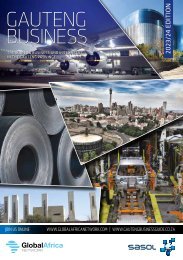Service Issue 81
Service magazine addresses key issues related to government leadership and service delivery in South Africa.
Service magazine addresses key issues related to government leadership and service delivery in South Africa.
Create successful ePaper yourself
Turn your PDF publications into a flip-book with our unique Google optimized e-Paper software.
S<br />
water<br />
Decay after progress: South<br />
Africa’s basic water supply services<br />
Water is at the heart of health and wellbeing for people and nature. Access to it is a human rights<br />
issue recognised by international declarations and national standards. It is vital for education<br />
and economic productivity. Ultimately, it connects the environment to society.<br />
By Anja du Plessis*<br />
TThe most recent statistics (2020) show a general global trend<br />
of positive progress in access to water. The proportion of<br />
the global population using safely managed drinking water<br />
services increased from 70.2% in 2015 to 74.3% in 2020. But despite<br />
this progress, in 2020, two-billion people still lacked safely managed<br />
drinking water. The Sub-Saharan African region has the largest<br />
numbers, with 387-million people without access to basic drinking<br />
water services. Current coverage of access to regulated drinking<br />
water is estimated at only 54% of the region’s population.<br />
In South Africa, the right to water is enshrined in the Constitution.<br />
Before the country’s transition to democracy in 1994, government<br />
policies were focused on the advancement of the white minority.<br />
The development of the country’s water<br />
resources did not consider improving the<br />
position of the mostly black, poor majority.<br />
South Africa has made significant<br />
progress since then in expanding water<br />
services, especially within the disadvantaged,<br />
vulnerable communities and rural areas.<br />
But inequality in access to basic services is<br />
still a reality. Progress with water supply and<br />
sanitation service delivery has been slow and<br />
in some instances, it’s deteriorating.<br />
Water is a critical resource. Its provision<br />
should be seen as an enabler that<br />
facilitates socioeconomic development.<br />
Water infrastructure needs to be suitably<br />
maintained – and upgraded – to ensure<br />
water access and reliable supply to guarantee<br />
water security.<br />
development, improving the quantity and the quality of water supply<br />
to citizens. This created a comprehensive legislative framework for<br />
the provision of water and sanitation services.<br />
Progress was subsequently made by advancing and extending<br />
water supply to rural areas and previously under-serviced areas.<br />
During the first decade of democracy, an estimated 13.4-million<br />
more people had access to basic water supply services.<br />
WATER ACCESS REALITY<br />
South Africa’s water situation has since deteriorated. The reliability<br />
of water services and infrastructure – as shown by frequent water<br />
supply interruptions – has been on a downward trend. It’s important<br />
PROGRESS IN SOUTH AFRICA<br />
In 1994, about 14-million people (35%)<br />
in South Africa didn’t have basic water<br />
supply services. The minimum standard<br />
of these services is defined as clean, piped<br />
water delivered within 200 metres of a<br />
household at a minimum flow rate of 10<br />
litres per minute, for 300 days a year, with<br />
any interruption not lasting longer than two<br />
days at a time.<br />
The government adopted various policies<br />
and programmes aimed at sustainable water<br />
Water infrastructure delivered versus vs water supply in 2021.<br />
Credit: National Integrated Water Information System.<br />
22 | <strong>Service</strong> magazine


















